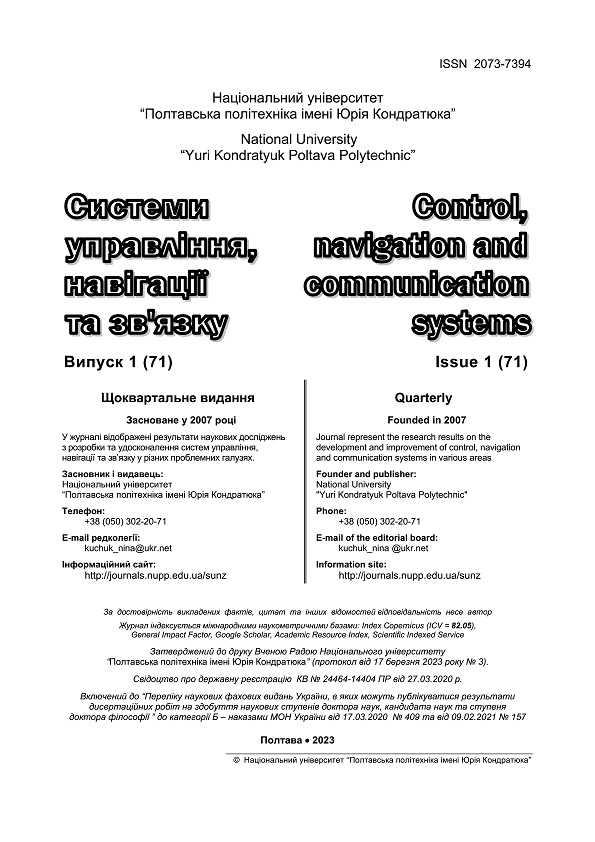AGGREGATION OF STRUCTURAL MODEL OF COMPLEX NETWORK SYSTEMS
DOI:
https://doi.org/10.26906/SUNZ.2023.1.138Keywords:
structural model aggregation, structural model transformation, complex systems, system dimension reduction, maximum flowAbstract
Complex systems require special methods of analysis and design. The main goal of these methods is to reduce the size of the system. It is necessary to find a simpler representation of such systems while preserving the properties of the system with initial dimension. In this paper formal transformations of structural model of the system using aggregation are reviewed. This approach leads to reduction of system dimension and computational complexity. The subject of research is the methods of structural model transformation of the systems. The goal of this work is to investigate the aggregation of structural model of systems which provides the reduction of system dimension, computational complexity and time of problem solving. The relevance of this research is that several problems can be solved at a higher level of the system hierarchy, which can be obtained as a result of structural model aggregation of the system. The following tasks were solved in the work: structural model transformations of the system and creation of the hierarchical system using aggregation; evaluation of the effectiveness of structural model transformation of the system by solving the maximum flow problem. As a result of this research a hierarchical system was created; the effectiveness of the method was demonstrated on the example of solving of the maximum flow problem. The results of evaluating the effectiveness of structural model transformations of the system: the number of elements of the system, the number of connections between elements of the system, and the number of graph traversal iterations are reduced; the value of the maximum flow is the same at two levels of the system. The studies allow us to conclude that the structural model transformation methods provide a simpler representation of complex systems while preserving the topological properties of the system at a higher level; as a result of the aggregation of the structural model, dimension of the system, computational complexity and time of problem solving are reduced; aggregation provides efficient ways to compute desired quantities for systems by reducing dimension of the system.Downloads
References
Newman M. (2010), Networks: An Introduction, Oxford University Press.
Lu J., Chen G., Ogorzalek M., Trajkovic L. (2013), “Theory and Applications of Complex Networks: Advances and Challenges”, Proceedings of the IEEE International Symposium on Circuits and Systems, pp. 2291–2294.
Landi P., Minoarivelo O.H., Brännström Å., Hui C., Dieckmann U. (2018), “Complexity and stability of ecological networks: a review of the theory”, Population Ecology, pp. 319–345.
Shortle J.F., Mark B.L., Gross D. (2009), “Reduction of closed queueing networks for efficient simulation”, ACM Transactions on Modeling and Computer Simulation, Vol. 19, No. 3, Article 10.
MacKay R.S., Robinson J.D. (2018), “Aggregation of Markov flows I: Theory”, Philosophical Transactions of The Royal Society A Mathematical Physical and Engineering Sciences.
Liu J.X., Vorst N.V. (2012), “Realizing Large-Scale Interactive Network Simulation via Model Splitting”, Proceedings of the 26th Workshop on Principles of Advanced and Distributed Simulation (PADS 2012), Zhangjiajie, China, pp. 3–12.
MacKay R.S. (2011), “Hierarchical aggregation of complex systems”, Proceedings of the ECCS’11, Vienna, Austria.
Gorbachov V., Sytnikov D., Ryabov O., Batiaa A. K., Ponomarenko O. (2020), “Dimension Reduction for Network Systems Using Structure Model Aggregation”, International Journal of Design & Nature and Ecodynamics, Vol. 15, No. 1, pp. 13–23.
Mesarović M., Mako D., Takahara Y. (1977), Theory of Hierarchical Multilevel Systems, New York: Academic.
Gorbachov V., Batiaa A. K., Ponomarenko O., Romanenkov Y. (2018), “Formal transformations of stuctural models of complex network systems”, Proceedings of the IEEE 9th International Conference on Dependable Systems, Services and Technologies DESSERT′2018, Kyiv, Ukraine, pp. 473–477.
Cormen T., Leiserson C., Rivest R., Stein C. (2009), Introduction to algorithms, 3rd ed.
Ford L., Fulkerson D. (1956), “Maximal Flow Through a Network”, Canadian Journal of Mathematics, 8, pp. 399–404.




